
The Hiller YH-32 Hornet was an American ultralight helicopter built by Hiller Aircraft in the early 1950s. It was a small and unique design because it was powered by two Hiller 8RJ2B ramjet engines mounted on the rotor blade tips which weigh 13 lb (5.9 kg) each and deliver an equivalent of 45 hp (34 kW) for a total of 90 hp (67 kW). Versions of the HJ-1 Hornet were built for the United States Army and the United States Navy in the early 1950s.

A backpack helicopter is a helicopter motor and rotor and controls assembly that can be strapped to a person's back, so they can walk about on the ground wearing it, and can use it to fly. It uses a harness like a parachute harness and should have a strap between the legs. Some designs may use a ducted fan design to increase upward thrust. Several inventors have tried to make backpack helicopters, with mixed results.

The Seibel S-4 was a two-bladed, single-engine helicopter built by Seibel Helicopter. Designed by Charles Seibel, the S-4 was evaluated by the United States Army under the designation YH-24 Sky Hawk, but would be rejected for service. The S-4B would serve as the basis for the design of the Cessna CH-1 Skyhook, the only helicopter Cessna ever produced.
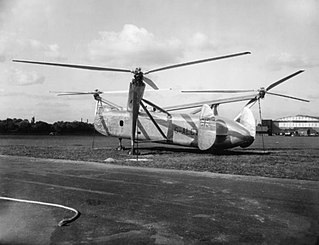
The Cierva W.11 Air Horse was a helicopter developed by the Cierva Autogiro Company in the United Kingdom during the mid-1940s. The largest helicopter in the world at the time of its debut, the Air Horse was unusual for using three rotors mounted on outriggers, and driven by a single engine mounted inside the fuselage.
The SNCASE SE.3120 Alouette ("Lark") was a utility helicopter developed in France in the early 1950s but which did not enter production. Designed in parallel with the SE.3110, the Alouette shared that machine's dynamic components, with the exception of its unusual twin tail rotor. The Alouette featured an open-framework fuselage behind a cockpit that was enclosed by a bubble canopy. Skid undercarriage and tricycle gear were both tested.

The Gyrodyne RON Rotorcycle was a tiny, single-seat helicopter designed under contract for the United States Navy. in the mid-1950s. It later was redesigned for a U.S. Marine Corps requirement for a small personal helicopter that would fulfill a number of roles, including observation, liaison, small unit tactical maneuvers, and which could be dropped to downed airmen behind enemy lines to facilitate their escape.
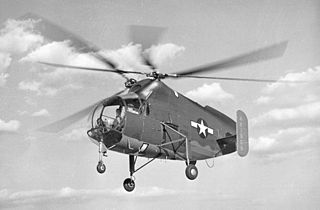
The Kellett XR-8 was a helicopter built in the United States during World War II. It was a two-seat machine intended to demonstrate the feasibility of a twin-rotor system, and while it accomplished this, it also demonstrated a number of problems that prevented further development of this particular design.

The Kellett XR-10 was a military transport helicopter developed in the United States in the 1940s that only flew in prototype form. It was designed in response to a USAAF Technical Instruction issued for the development of a helicopter to transport passengers, cargo, or wounded personnel within an enclosed fuselage. Kellett's proposal followed the general layout that the company was developing in the XR-8, with twin intermeshing rotors, and was accepted by the Air Force on 16 October over proposals by Sikorsky, Bell, and Platt-LePage.

The Piasecki H-16 Transporter was a tandem-rotor transport or rescue helicopter designed by Frank Piasecki and built by Piasecki Helicopter. The prototypes were evaluated by the United States Air Force and Army, but the crash of the second test aircraft led to cancelling the project.
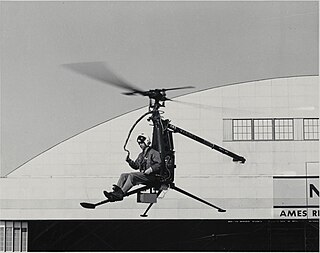
The Hiller ROE Rotorcycle was a single-seat ultralight helicopter designed in 1953 for a military requirement. A total of 12 were produced for the United States Marine Corps. And in 1954, the Hiller Helicopters was selected by the US Navy's Bureau of Aeronautics to build this design of a one-man, foldable, self-rescue and observation helicopter. It featured a two-blade rotor system. Its original empty weight was 290 lb (132 kg).

The McDonnell XHJH Whirlaway, aka McDonnell Model 65, was a 1940s American experimental transverse-rotor helicopter designed and built by McDonnell Aircraft Corporation for the United States Navy and was the largest helicopter at the time, as well as the first successful twin-engined twin-rotor helicopter in the world.

The HZ-1 Aerocycle, also known as the YHO-2 and by the manufacturer's designation DH-5 Aerocycle, was an American one-man "personal helicopter" developed by de Lackner Helicopters in the mid-1950s. Intended to be operated by inexperienced pilots with a minimum of 20 minutes of instruction, the HZ-1 was expected to become a standard reconnaissance machine with the United States Army. Although early testing showed that the craft had promise for providing mobility on the atomic battlefield, more extensive evaluation proved that the aircraft was in fact too difficult to control for operation by untrained infantrymen, and after a pair of crashes the project was abandoned. A single model of the craft was put on display.
The I.P.D BF-1 Beija-Flôr was a two-seat light helicopter designed by Henrich Focke.
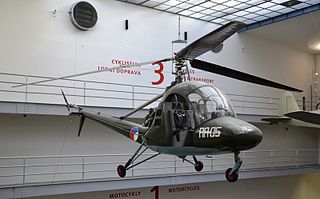
The Aero HC-2 Heli Baby is a two-seat light general-purpose utility helicopter, designed by engineer Jaroslav Slechta, and produced by the Czechoslovakian company Aero Vodochody in the 1950s. It has a three-bladed main rotor, and a two-bladed tail rotor. The helicopter has an entirely metal frame and cockpit, and windows made of Plexiglas. It was the first and the only Czechoslovakian-designed helicopter to be produced.

The SNCASE SE-3101 or Sud-Est SE-3101 was an early, experimental French helicopter with twin tail rotors. Only one was built.

The Matra-Cantinieau MC-101 was an early 1950s French experimental two seat helicopter of conventional tail rotor configuration but with its engine mounted close to the main rotor, above the seating.
The Nord 1700 Norélic or SNCAN N.1700 Norélic was a French helicopter with several novel control features. Only one prototype was built, though it was intended to lead to series production.
The Gyrodyne GCA-2 was a general-purpose helicopter built by the Gyrodyne Company of America in the late 1940s.
The Kaman K-17 was a two-seat experimental helicopter built by Kaman in the late 1950s. It used a cold-jet rotor system.
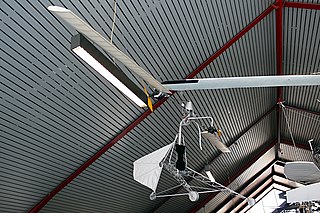
The Nagler-Rolz NR 54 is an Austrian experimental foldable backpack helicopter developed during World War II. An enlarged variant, the NR 55, was also built.















